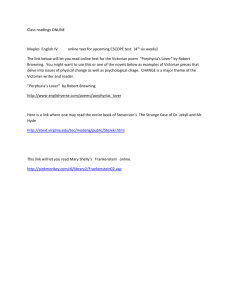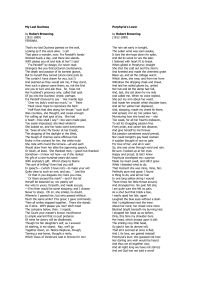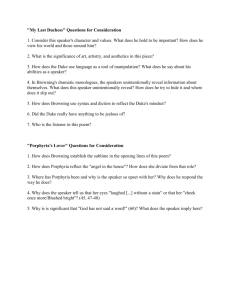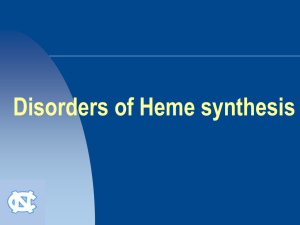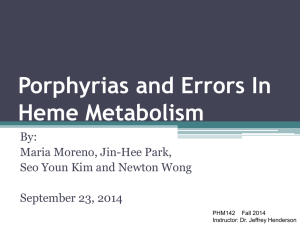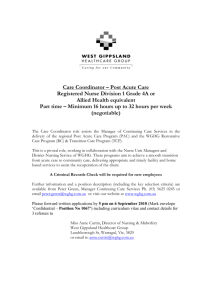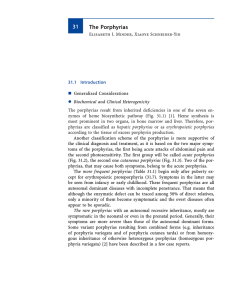Behavioural Aspects of Acute Intermittent Porphyria
advertisement
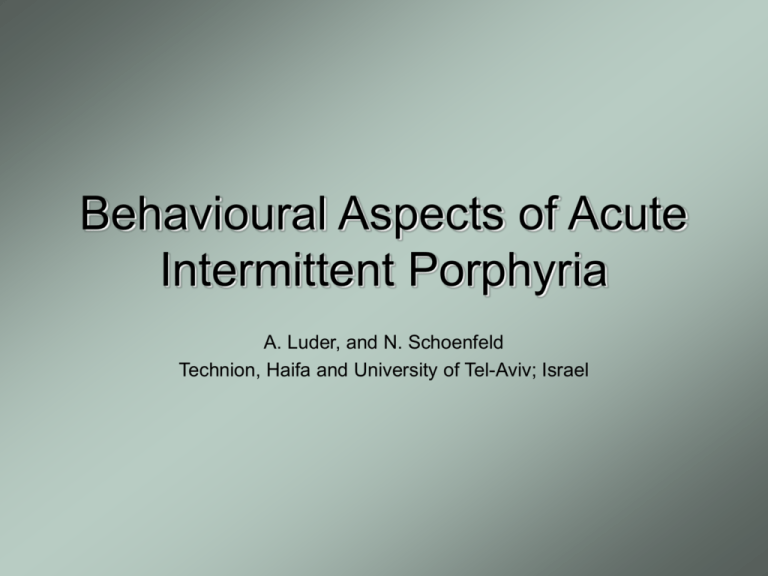
Behavioural Aspects of Acute Intermittent Porphyria A. Luder, and N. Schoenfeld Technion, Haifa and University of Tel-Aviv; Israel 4 Acute Porphyrias: ALA dehydratase deficiency AIP Variegate Hereditary coproporphyria 4 Chronic porphyrias: Porphyria cutanea tarda PCT Erythropoietic protophorphyria Congenital erythropoietic porphyria (Gunther’s) Pseudoporphyria (porphyrinuria) CATEGORY Hepatic Erythropoietic TYPE CLINICAL PRESENTATION INHERITANCE ALA dehydratase deficiency Acute attacks Autosomal recessive Acute intermittent porphyria Acute attacks Autosomal dominant Porphyria cutanea tarda Skin disease Usually acquired; a minority are inherited (autosomal dominant) Hereditary coproporphyria Skin disease, acute attacks Autosomal dominant Variegate porphyria Skin disease, acute attacks Autosomal dominant Congenital erythropoietic porphyria Skin disease Autosomal recessive Erythropoietic protoporphyria Skin disease: specific presentation with immediate photosensitivity Autosomal dominant: severe forms have complex inheritance Hydroxymethylbilane Erythropoeitic The Case of N.H. • 14 year-old girl was referred for genetic evaluation by Child Psychiatrist and Child Development Center in because of severe pervasive developmental disorder with autistic features, behavioural disturbance, and MR • Only child of single pregnancy, unrelated healthy parents of Indian Jewish (Cochin) descent • Pregnancy after Pergonal therapy for infertility • Pregnancy delivery and early life normal, BW 2.9 Kg • Parents healthy, unrelated. Family history negative for early death, retardation, chronic or psychiatric disease The Case of N.H. • Early psychomotor development normal • Age 3 Otitis media and febrile disease • Age 4 referred to developmental evaluation for speech delay • Seen by 2 geneticists who raised the possibility of Rett syndrome • “Metabolic work-up” at a major hospital – negative • Treated with Favoxil (Fluvoxamine maleate; 5-HT reuptake inhibitor; UWECO) Mellaril (Thioridazine; phenothiazine; UWC) and Minirin (Desmopressin acetate; vasopressin analogue; UWC) ** Drug use codes: University of Cape Town Porphyria Service http://web.uct.ac.za/depts/porphyria/professional/prof%20index.htm The Case of N.H. • • • • • • • Age 14 re-investigated Brain MRI: Mild cerebral atrophy R>L CSF normal, neurotransmitters normal Catecholamine excretion normal OA: Increased urinary fumarate, 2-ketoglutarate AA: Increased alanine and glutamate Lactate/pyruvate, ammonia, carnitine, VLCFA, transferrin isoforms – normal • FRAXA and MeCP2: no abnormalities • Muscle biopsy: PDHC, ETC enzymes and histiochemistry normal • Fibroblasts: normal fumarase activity The Case of N.H. • Age 16 no specific diagnosis • Parents report severe behavioural deterioration before menstruation – shrieking, violence, uncontrollable agitation and crying • Started on OC (Harmonet gestodene/ethinyloestradiol) but with further deterioration including vomiting and stuporous attacks requiring hospitilization • On further questioning – NH dislikes sun exposure and becomes very irritable • NH’s mother – chronic constipation, pre-menstrual pain, dislikes sun exposure (but no rashes) • Porphyria suspected The Case of N.H. Aminolevulenic Porphobilinogen RBC PBGD *** Acid 24 hr. excretion 24 hr. excretion* ** N.H. 1st. N.H. 2nd. 4.3 4.7 1.7 2.5 15 13 O.H. (mother) 5.4 3.0 17 Normal: * <5 mg/24hrs; ** <2 mg/24hrs; 25-45 nmol urop./ml/h Studies by N. Schoenfeld, Beilinson Hospital, Petah Tiqwa, Israel The Case of N.H. • Is the diagnosis of AIP established? • Lack of convincing biochemical evidence • Enzyme levels at heterozygote levels – possible overlap with normal individuals • Dangerous to rely on metabolic/enzymatic evaluation of an individual. Efforts should be made to: – Repeat studies – Study first-degree relatives – Confirm with molecular studies The Case of N.H. Acute Attacks RBC PBGD, % normal * Urinary ALA mol/24h ** Urinary PBG mol/24h *** Mutation analysis G532A ++ 42 32.7 11.0 +/- O.H. (mother) - 50 41.2 13.3 +/- D.H. (father) - 90 nd. nd. -/- N.H. Normal: * >70% ** <38 *** <8.8 Data: Minder EI, Schneider-Yin X, Zentrallabor, Staatspital Triemli, Zurich, Switzerland The Case of N.H. • • • • Diagnosis: Acute Intermittent Porphyria Family member affected No other pathology discovered Unusual phenotype N.H. Treatment • Treatment of behavioural problem difficult because of drug intolerance • High carbohydrate diet • Avoidance of stress, sun, infections • “Correct” drug therapy • Acute attacks – Haem iv, iv fluids and glucose, analgesics, psychiatric management N.H. Treatment • Currently managed with decapeptyl (triptorelin; GnRH analogue) for menstrual aggravation • Aggression and agitation treated with small doses of haldol (haloperidol; butyrophenone) 0.5 mg/d • ?ECT - Little experience in acute porphyria (beware of barbiturate anaesthetic agents) Onset of Catatonia • Recent onset of hypokinesis and “freezing” during initiation and performance of daily activities • Differential diagnosis: – – – – Adult autistic complication Schizophrenia Severe depression Parkinsonism • Managed with reduction in does of haldol and introduction of amantidine • Started on Zyprexa olanzapine, (serotonin 5-HT2 and dopamine D2 receptor antagonist) * *Taylor, Francis. International Journal of Psychiatry in Clinical Practice 2003; 7:67-69 AIP • Acute intermittent porphyria occurs in all races • The symptoms of acute intermittent porphyria rarely occur before puberty. An attack may last for several days or longer and often requires hospitalization • PBG, uroprophryin, and 5-ALA accumulate in the plasma and the urine Terminology • • • • • • • • • • • AIP Hydroxymethylbilane synthase deficiency Intermittent acute porphyria syndrome PBGD deficiency Porphobilinogen deaminase deficiency Porphyria, Swedish type Pyrroloporphyria Swedish genetic porphyria Swedish porphyria UPS deficiency Uroporphyrinogen I synthase deficiency AIP • 1-5 cases per 100,000 (US) 60-100 per 100,000 Sweden • AD but female:male ratio 1.5-2.1:1 • Most cases become symptomatic 18-40 years. Presentation before puberty or after 40 is unusual Presentation • • • • • • Colicky abdominal pain 95% Pyschiatric symptoms – depression, hysteria Peripheral neuropathy 66% Long symptom-free periods are characteristic Skin manifestations are absent (MR and pre-pubertal PDD have not been previously described in the literature) Abdominal Pain • The abdominal pain is severe and lasts for several days. Pain of short duration (<1 d) or chronic abdominal pain is not observed in AIP • The pain often is severe, epigastric and colicky in nature • Patients often are free of pain between attacks • Constipation is common and can be very severe • Frequently, nausea and vomiting are present Neurovisceral and Autonomic Involvement • Nausea, constipation, colicky abdominal pain, vomiting, urinary and fluid retention, hypertension, tachycardia, increased sweating and intermittent fever Peripheral Nerve Involvement • Peripheral neuropathy, weakness and aching in muscles and joints, unsteady gait, poor coordination, numbness/ tingling of arms and legs • Guillain-Barré syndrome classic or assymetric • Tendon reflexes maybe reduced normal or brisk Sensory Syndrome • Neuropathic pain syndrome: Diffuse, Proximal & Distal; Abdominal • Sensory loss: Usually mild, distal, symmetric • Usually patients have concurrent neurologic or abdominal symptoms CNS Involvement • Seizures, mental status changes, cortical blindness,coma, delirium, depression, headaches, difficulty concentrating, personality changes Physical Signs • From 30-80% of patients have tachycardia • Fever can be present in some patients • Hypertension is observed in half of patients and may persist between attacks Neurological Signs • Motor neuropathy, more predominant in the lower limbs • Areflexia frequent • Any nerve can be involved, including cranial neuropathies • Cortical blindness • Neurological symptoms affecting the central, peripheral and/or autonomic nervous systems: Precipitating Factors • An inherited deficiency of PBGD is necessary but not sufficient to cause clinical disease in AIP • On average, out of 100 patients with the genetic defect, perhaps 10-20 secrete excess porphyrin precursors and only 1-2 have symptoms • Precipitating factors can induce cytochrome P450 and ALAS1 and thereby increase the demand for haem synthesis Precipitators • • • • • • • • Fasting, ketoacidosis Stress, surgery Hormonal Drugs barbiturates, oral contraceptives and estrogens, sulfa drugs, cocaine, griseofulvin (Fulvicin), chloroquine phosphate (Aralen), methyldopa (Aldomet), Diet and dieting Alcohol smoking Acute infections Unknown Psychiatric Aspects • Diagnosis is based on a high index of suspicion and appropriate investigation • Consistently higher rates of porphyria have been found in psychiatric patients (up to 0.3%) • Some psychotropic drugs have been safely used in the treatment of AIP, but many others (eg. barbiturates, phenothiazenes, benzodiazepines, serotonin uptake anatagonists) may precipitate attacks and are forbidden or problematic • Little information about the safety of newer psychotropic drugs Psychiatric Involvement • The relationship between acute intermittent porphyria and psychiatric symptoms is complex. Porphyria may present with only psychiatric symptoms • Porphyria may mimic a wide variety of psychiatric conditions, and, conversely, psychiatric symptoms may manifest secondary to the porphyria • Well described: • Psychosis similar to schizophrenia • Histrionic personality disorder which may not receive much attention • Not described: • Pervasive developmental disorder • Mental retardation • Complex behavioural and personality disorder in childhood Psychiatric Symptomology • Patients without acute attacks may have chronic, mild non-specific complaints but be at risk for acute crises in the future • Affective symptoms: Emotional lability, insomnia, grandiose delusions, conduct disorder with disruptive behavior, impulsive behavior, aggression, encopresis, hyperactivity • Neurotic symptoms: Anxiety (26%) *, restlessness, agitation, depression (13%) *, hysteria, phobias, conversion disorder, chronic fatigue syndrome and somatization disorder * Millward, Kelly, King, Peters Journal Inherited Metabolic Disease 2005;28:1099-107 Psychiatric Symptomology • Suicide and attempted suicide • Pseudo-PMT syndrome • Organic disorders, delirium, and altered consciousness ranging from somnolence to coma •This condition may have inspired the vampire and werewolf legends •Poe's Roderick Usher ("Fall of the House of...") was perhaps based on someone with acute intermittent porphyria (JAMA 261: 863, 1989) •UMKC's Loretta Loftus et. al. suggests porphyria as the cause of Vincent VanGogh's craziness (Br. Med. J. 303: 1589, 1991) Flourescent teeth Red-stained teeth King George III Syndrome • Nervous trembling, altered consciousness, intractable pain, and terrible insomnia • Possible trigger factor – erratic eating habits • Late onset – after 50 years Neurotoxicity Mechanisms • Most current thinking focuses on accumulations of toxic metabolites. • Delta-amino levulinic acid (DALA) and porphobilinogen (PBG) are neurotoxins that produce cerebral dysfunction and damage (confusion, "psychiatric disease"), autonomic neuropathy (constipation, urinary retention, tachycardia, hypertension) and severe (sometimes chronic) abdominal pain – mechanisms unclear • DALA may be a false transmitter for GABA. It also blocks one of ATP-ases (perhaps a sodium pump). • Another hypothesis – unsaturation of hepatic tryptophan pyrrolase secondary to liver haem deficiency leads to altered tryptophan delivery to CNS – increased tryptophan excretion • Other theories – vasospasm, reduced NOS activity, impaired GTP formation, PLP deficiency Genetics • Porphobilinogen deaminase deficiency PBGD • EC 2.5.1.61, Chromosome 11q24.1-q24.2, AD • Alternative name: Hydroxymethylbilane synthase HMBS Genetics • • • • More than 60 mutations described Common sites: Exons 10, 12 & 14 (35% to 50%) None in exons 2 & 13 Mutations commonly unique to individual or very few families • Mutation types: Missense 41%; Truncating 59% • Porphobilinogen deaminase deficient mice: Porphyric syndrome with neuropathy Diagnosis • Urine PBG and DALA will be increased during acute episodes AIP (also variegate porphyria and coproporphyria.) • Urine rich in PBG turns reddish-purple (uroporphyrin) on long exposure to bright light (toilet, ward station, lab). "Porphyria" means "purple" • Levels can be normal between attacks • Urine "dipstick" test for urobilinogen should record PBG but in practice unreliable because PBG is very unstable • Since not every acute porphyrin is AIP, foecal porphyrin and RBC PBGD activity should also be evaluated together with plasma flourescence scan Correct Collection of Specimens • Use light-proof bottle (wrap it in aluminum foil.) • Urine should be alkalinized and refrigerated. • High pressure liquid chromatography to screen for DALA and PBG – 24 hour excretion Definitive Diagnosis • The definitive test is to measure monopyrrole porphobilinogen deaminase (uroporphyrinogen I synthetase) in RBCs • Some overlap with normal individuals is seen • Determination of mutation in PBGD gene • Family member studies Porphyria – An Imitator • This diagnosis should be entertained in the following situations: • • • • • • • unexplained leukocytosis unexplained neuropathy aetiologically obscure neurosis or psychosis 'idiopathic' seizure disorder unexplained abdominal pain susceptibility to stress ?unexplained PDD, MR or behavioural disturbance in childhood? Pitfalls • Some patients exhibit no hard physical findings, and the patients get dismissed for years as "functional", “malingerers”, "mentally ill", or "drug seekers“ • The screening tests are often done on samples that have been handled improperly, resulting in falsenegative results • Diagnostic criteria are poorly-defined. Mild versions are surely common and are missed by the standard enzyme "normal ranges“ • Identification of a biochemical or genetic anomaly is not in itself and indicator of clinical disease • Is there another co-existing condition? Treatment Dilemmas • • • • Safe and unsafe drugs, UWC, UWECO drugs Side effects v. progression of disease Drug interactions Better modalities for follow-up needed Achbara Bridge, near Safed, Israel
